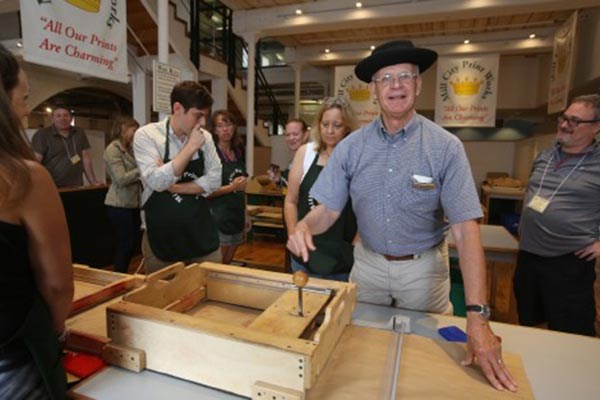
07/16/2015
Lowell Sun
By Alana Melanson
LOWELL -- As one teacher operated the wheel to turn the paper roll, another drew borders while others stamped stems, leaves and flowers.
In a labor history simulation held Wednesday at Boott Cotton Mills, teachers became mill workers on an assembly line in 1850, stamping the designs onto "tea towels" while museum teacher Paul Levasseur, pretending to be the shop director, barked orders at them and rang bells.
As he taught them about the long work days, poor working conditions and very low wages mill workers of that era faced, the teachers had to react to different scenarios, such as other line workers being fired for not working quickly enough and being replaced by cheaper, immigrant laborers.
"If you make a mistake, you broke a deadline, you're going to ruin everything else down the line," Levasseur told them.
While their students are enjoying summer activities, 35 teachers from 27 states are delving into local history lessons they'll be bringing back to their classrooms this fall.
"Inventing America: Lowell and the Industrial Revolution," a weeklong program for teachers at the Tsongas Industrial History Center, along with another session held the last week of June, were made possible by a $160,286 National Endowment for the Humanities grant, according to Tsongas Industrial History Center Director Sheila Kirschbaum.
The center has received more than $1.
7 million in grant funding from NEH over the nine years the program has been offered since 2006 -- it wasn't held in 2014 -- allowing a total of 900 teachers to participate, she said. All but three states -- Delaware, Nevada and South Dakota -- have been represented, Kirschbaum said.
The Lowell workshop has been funded more times than any other project through NEH, which she said shows the quality of the resources of Lowell National Historical Park.
It also shows the quality of the program and its guest lecturers, who have immense knowledge of the time period, said UMass Lowell history Professor Bob Forrant, who worked on the grant with Kirschbaum.
Over the course of the week, the teachers are learning about a number of topics during the early Industrial Revolution, including labor, hand production of cloth, mill life and water power. They're also enjoying excursions to places like Old Sturbridge Village and Concord's Walden Pond.
"It's important to figure out how to help teachers do a really dynamic job teaching this portion of American history, because it's the foundation for everything that's going to come after, and we're still affected by things that happened in the early 19th century today," said Forrant.
Bryan Sheckman, a history teacher at Lowell High School, said he feels aspects of the program should be part of orientation for incoming teachers working in the city.
"I kind of knew all of this was around me teaching in Lowell for a year, but getting the more hands-on approach into it has been very helpful," he said. "It has given me lot of perspective of the city where I'm teaching and where the families come from."
Lisa Tice, a fourth-grade teacher at Chelmsford's South Row Elementary School, said opportunities like this for elementary school teachers have been rare but more are becoming available due to pressure to implement the Common Core State Standards. She said workshops like this are an opportunity for teachers to educate themselves in order to excite and engage their students through hands-on learning and historically accurate stories.
"We have the responsibility of not continuing the myth of chopping down the cherry tree with George Washington," Tice said, citing one example of historically inaccurate and simplified stories often told to children. "We could tell young children the real story, in framing our language, that we can put an end to the fictionalizing of some of these people -- that they had flaws, but were also extremely important to why we're here."
Katelyn Graham, a fourth-grade teacher at Campbell Elementary School in Dracut, said she was drawn to the local history.
"The kids don't know there's such a rich culture here," she said. "They don't realize there's such history right here in their backyard."
Graham said the knowledge will help her find ways to give her students historical context to a number of things, from better preparing them for field trips to explaining how the Lowell Spinners got their name. During the assembly line simulation, she said she was already thinking about she could replicate the eye-opening lesson in her classroom.
While Gerardine Carroll, a high-school teacher in Seattle, said she teaches more world history than U.S. history, what she's learning this week will allow her to make connections between what happened here at the beginning of the Industrial Revolution and what is happening now in developing nations and the effect of the global economy.
Ileana Simien, a high-school teacher in Houston, said the workshop will help to fill in a gap of U.S. history that often does not receive much attention in the South, where she feels the focus is often more on the Civil War and slavery. She said she has skimmed over Lowell and the Industrial Revolution, but now she feels much more confident about teaching it.
"Now that I'm in the city, and I know it, and I can actually see it, there's a lot of stuff I can take back," Simien said.
